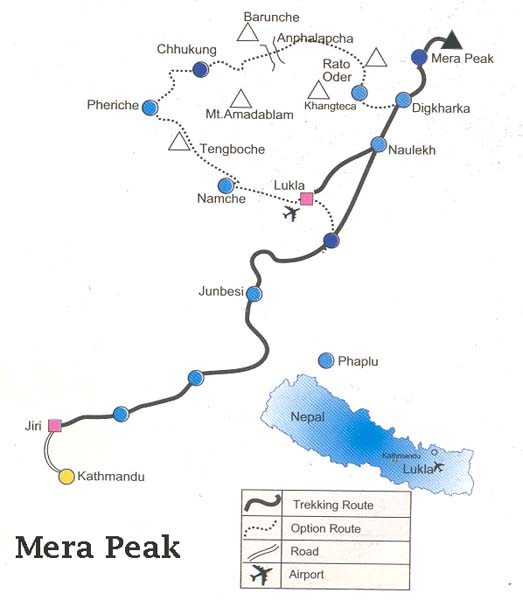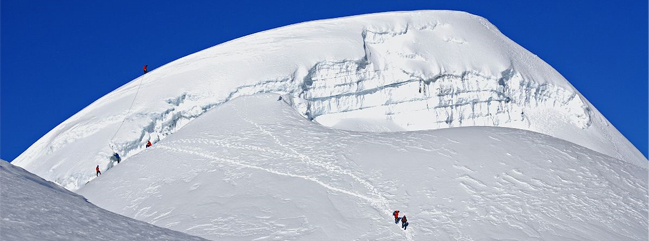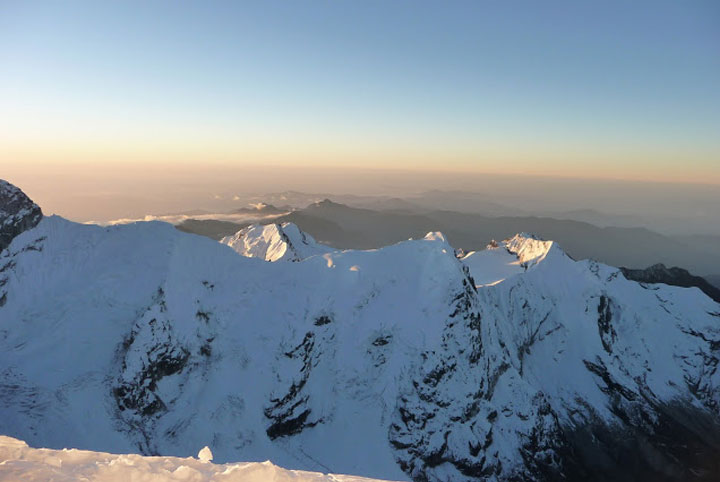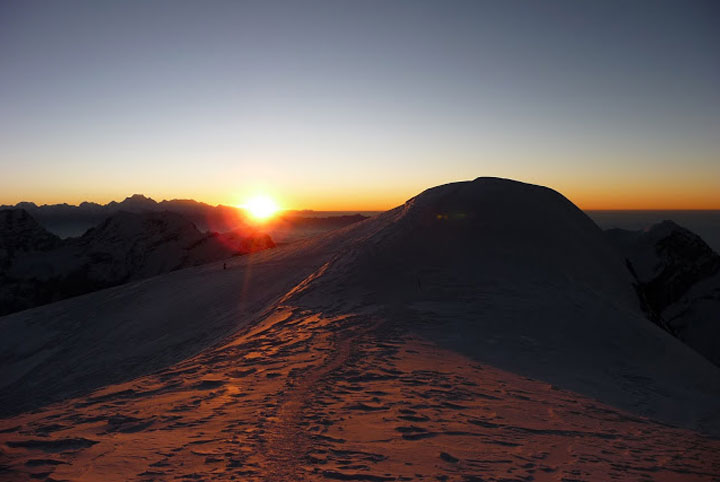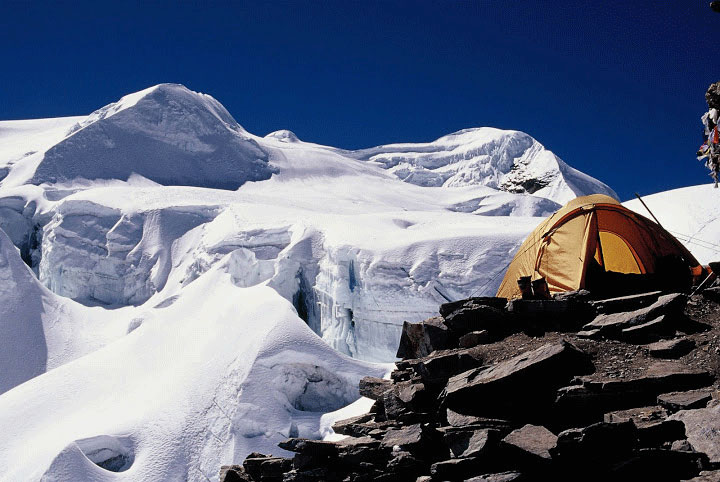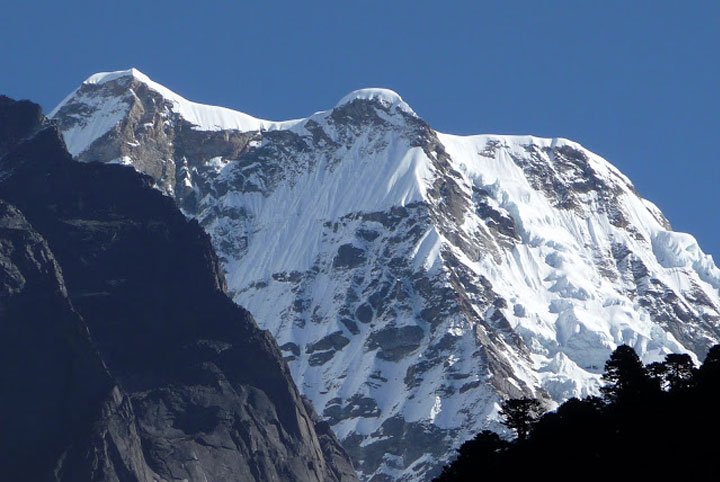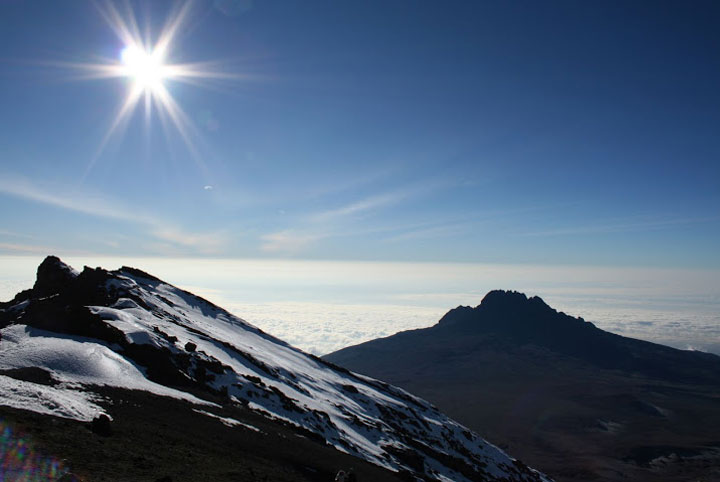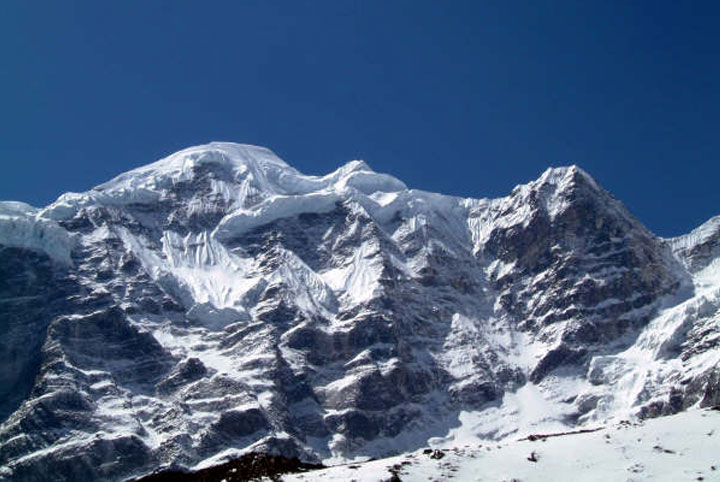Like every treks and climbing trips, the trek to Mera starts with a bracing mountain flight to Lukla airstrip. From Lukla, we ascend slowly to eastward, cross the Zatra pass and finally we reach the Mera La pass on 9th day. We set up our base cam there for Mera peak climbing. It is possible to climb the Mera peak in one day but we avoid the rush. We take enough time for proper rest and acclimatization.
Mera peak is the highest permitted trekking peaks in Nepal. It rises to the south of the Everest and dominates the watershed between the wild and the heavily wooded valleys of the Hinku and Hongu Drangkas. Mera peak is an opportunity to venture into a little visited and as yet unspoiled region of Nepal where the hillsides are still densely forested. It also offers a pleasure of going above 21000 feet. Both Hinku and Hongu valleys remain inhabited. However, there are few Kharkas in the upper Hinku basin. The Sherpa people from south graze their cattle there during grass-growing monsoon. The upper Hongu basin is truly a mountain wilderness, place of massive moraines, glacial lakes and spectacular view of the peaks like Chamlang and Bruntse.
Mera Peak ClimbingThe Mera peak also offers some of the most spectacular mountains scenery, pristine forest and high altitude climbing in the world. We’ll set up two more high camps, the first over 300 m above B.C. on the Mera Glacier, and the second after we cross the Mera crevasse field at 5,800 m. From here it is a steady and steep climb to reach the summit, with awe-inspiring views of Kanchenjunga and Makalu to the east, Everest and Lhotse to the north, and Ama Dablam and Cho Oyu to the west.
Mera peak is considered the major and popular trekking peaks in Nepal. It rises to the south of Everest. The ascent of the peak is technically straightforward. But the heavy snow and maze of the crevasses make the way to summit longer. There are several approaches to the base camp besides the easy and normal route which is mentioned below. The normal route for climbing Mera Peak is North Face Glacier from the Mera La. The base camp can be set up at 5,300m on the Hongu side in the moraine below the ice. Normally, high camp is set at 5,800m near a rocky outcrop on the Mera Glacier.
Day 01- Arrival in Kathmandu airport (1345meters).
There you will be met by our Airport Representative and transferred to hotel by private tourist vehicle. Overnight at hotel.
Day 02- Pre-trip Meeting and Sightseeing around Kathmandu valley.
In the morning after breakfast at 9 AM, we host a Pre-Trip meeting at your hotel in Kathmandu and introduced your trek Leader/Guide mean time and it will provide an opportunity for individuals to ask questions about the your trek and to introduce you to other participants. This includes a final briefing and preparations for the trip.
PLEASE ADVISE US IF YOU WILL BE ARRIVING LATE AND ARE THEREFORE UNABLE TO ATTEND THE PRE-TRIP MEETING.
In THE PRE-TRIP MEETING All passengers MUST bring:
1. Passport.
2. Four copies of Passport size photos each.
3. Travel Insurance Policy.
4. A writing pen
5. Notepad.
After the Pre-Trip meeting and breakfast your sightseeing trip will start at 9.45 AM in the morning. We provide a private vehicle and professional tour guide. We visit Bodhnath Stupa, one of the biggest Buddhist shrines in the world, where we observe Buddhist monks in prayer in the monasteries surrounding the stupa. After Bodhnath Stupa we visit Pashupatinath, the most famous Hindu temple in the country, located on the banks of the holy Bagmati River. Here we see Hindu holy men (sadhus) meditating, pilgrims bathing and occasionally funeral pyres burning on the ghats. We also visit Bhaktapur Durbar Square, which is a collection of pagoda and shikhara – style temples grouped around a fifty-five-window palace of brick and wood. The attraction of the Bhaktapur Durbar Square is The Lion gate, The Golden gate, The Palace of fifty five windows, Art Galleries, The Statue of King Bhupatindra Malla.
The rest of our time in Kathmandu is free for further exploration and some last-minute shopping in Thamel area near by your hotel. Later, we are supplied with our Trek Pack and departure information for tomorrow. Overnight at hotel.
Day 03- Fly to Lukla (2804 meters) trek to Chutok (2800 meters) 3 hours.
An early morning start takes us to Tribhuwan international Airport in Kathmandu for the 35 minute scenic flight to Tenzing and Hillary Airport at Lukla at 2804meters. On arrival at the airport our guide will brief you and introduce our porters before we begin our trek towards up to the Chutok La pass at 2945meters and over night at Chutok at elevation of 2800meters. Overnight at tented camp.
Day 04- Trek – Col Khari La (3081 meters) to Pangkongma (2950 meters) 6 hours.
After the pass of Col Khari La the trail carries along mountain sides through the Khari Khola valley to set up camp in Pangkongma. Overnight at tented camp.
Day 05- Trek to Kurke (3800meters) 5 hours.
A magnificent route via mountain crests through rocky and wild landscapes. Passing through and enjoying the splendid panorama of wooded regions below us. Overnight at tented camp.
Day 06- Trek to Thuli Kharka (4200meters) 6 hours.
Today we climb up to a pass at 4400meters and descend towards Thuli Karkha, which mean “vast pasture”. Overnight at tented camp.
Day 07- Trek to Khothey (3600 meters) 5 hours.
We descend on hillsides, by pleasant meadows and lower down through forests of blue Himalayan pines and rhododendrons. Beautiful views of the south side of Mera Peak. Overnight at tented camp.
Day 08- Trek to Tangnag (4350meters) 6 hours.
We climb up the Hinku valley through summer pastures, near Lungsamba the valley narrows wedged between the Kusum Kangru 6369 meters and the west summit of Mera Peak 6255 meters. Overnight at tented camp.
Day 09- Acclimatization and Rest day at Tangnag.
Spending a day here in order to acclimatize and adjust to the thinning of the air. Overnight at tented camp.
Day 10- Trek to Khare (4900meters) 4 hours.
Climb up along the lateral moraine of the Dig Glacier, providing interesting views of the Mera Peak. Overnight at tented camp.
Day 11- Trek to Mera La (5415meters) and Base Camp (5300m) 5 hours.
Progressing along the snowy glacier, we approach the pass the slope becomes steep. Overnight at tented camp.
Day 12- Climb Base Camp to High Camp (5800meters) 5 hours.
One of the best parts of the trek. Stunning panoramas of giant mountains rising above 7000meters, among the highest on earth: Chamlang (7290meters), Makalu (8475meters) and Baruntse (7220meters) to the east, Everest (8848meters), Lhotse (8501meters) and Nuptse to the north. Continuing westward the peaks of Ama Dablam, Cho Oyo (8153meters) and Kantega fill our view. Overnight at tented camp.
Day 13- Summit to Mera peak (6654meters) and then return to Khare (4900meters) 10 hours.
Start early in the morning depending on the weather condition. Overnight at tented camp.
Day 14- Spare day in case of bad weather. Overnight at tented camp.
Day 15- Trek to Khothey (3600 meters). 6 hours.
Leaving the mountains behind us our descent takes us through Tangnag before continuing back to Khothey 3600meters. Overnight at tented camp.
Day 16- Trek to Thuli Kharka(4200 meters) 6 hours.
Our trek Descends back the same way. overnight at tented camp.
Day 17- Trek to Lukla (2804 meters) 7 hours.
Finally we return to Lukla where the trek began, which will seem like a lifetime ago. Enjoying time to reflect on the trek as a group and the personal achievement of all those who took part. Also giving you time to explore the town. Overnight at tented camp.
Day 18- Thirty five minutes flight to Kathmandu from Lukla early in the morning.
Enjoying your last glimpse of the mountains you have recently visited for one last time on the 35 minute Scenic flight back to Kathmandu. On arrival in Kathmandu we are met and transferred back to our starting hotel. Overnight at hotel.
Day 19- Leisure day in Kathmandu.
It’s also spare day in case of bad weather in Lukla, If you are interested in continuing onto Chitwan Jungle Safari, River Rafting Adventure, Kathmandu Shopping Tour or Scenic Everest Flight.
Day 20- Transfer to international airport for your final flight departure.
The trip ends, our Airport Representative will drop you to the Kathmandu international airport for your flight departure from Nepal.
NOTE: The above information is a guide and standard template of what we provide. The trek can be customized at your request to accommodate your specific requirements.
NOTE : On adventure trips of this type, weather, local politics, transport or a multitude of other factors beyond our control can result in a change of itinerary. It is, however, very unlikely that the itinerary would be substantially altered; if alterations are necessary the leader will decide what is the best alternative, taking into consideration the best interests of the whole group. Where a change does occur, we do everything we can to minimize its effect, but we cannot be responsible for the results of changes or delays.
Q. How fit do I have to be and is trip for me?
A. Climbing Peak provides the most adventurous experience with spectacular scenery through remote glaciated valleys and passes. This trip requires you to have an above normal level of fitness which will assist with climbing Peak. Any person suffering from a pre-existing medical condition or diseases must seek medical advice before considering this trek. Whilst on the trek, it is common to experience some discomfort before being fully acclimatized.
To prepare for a strenuous trek you should begin training at least two to three months before your departure. As a guideline, an hour of aerobic exercise three to four times per week would be considered a minimum requirement. The best preparation is bushwalking involving relatively steep ascents and descents. If you can manage a couple of valley floor to ridgeline ascents per comfortable and able to enjoy the trek to the fullest. They are physically strong, sharp-witted and have an incredibly positive attitude towards a life that we would consider extremely tough. There is something about a trek in the Himalaya that draws you back time and time again. For keen walkers it is a paradise and even avowed non-walkers find that one foot just seems to follow the other, drawn by the appeal of what lies beyond.
Q. Will somebody come to pick me up at the Airport upon my arrival?
A. Yes, our Airport Representative will be there to greet you outside of Terminal Hall, he/she will be displaying an Kiwi Adventures Treks & Expedition sign with your name on it. Upon arrival, you will be transferred to your hotel.
Q. What sort of accommodation can I expect in Kathmandu and in trekking?
A. We use standard rooms from three/four star hotels in Kathmandu with breakfast included. Along the trekking routes teahouses/Lodges generally provide basic clean facilities with a mattress and a quilt or blanket. We can also offer you sleeping bags if needed (which need to return after the trip) but it is good idea to always have your own sleeping equipment. We usually provide single and double rooms as well as the occasional dormitory. The dining room is downstairs around a fire. All food will be cooked to order in the little kitchen. You should not enter the kitchen unless asked to do so.
Toilet Facilities – On trek, common toilet facilities are available at Tea Houses.
Q. What sort of food can I expect in trekking?
A. Most teahouses (lodges) cook a delicious range of mostly vegetarian fare. Pasta, tuna bakes, noodles, potatoes, eggs, dhal bhat, bread, soups, fresh vegetables (variety depends on the season) and even some desserts like apple pies, pancakes, and some interesting attempts at custard. You will find a lot of garlic on the menu because it assists with acclimatization – eat some every day. In many larger villages you may find some meat on the menu. You can always get hot chocolate, tea, and hot lemon drinks, as well as soft drinks, and treats like chocolate and crisps.
During the Camping, our export camping cook can prepare specially requested food if you advise. In any case, you will have similar fare to teahouses.
Each day dinner and breakfast are used to take in the same lodge you spend the night. Lunch will be taken on the way to destination.
Q. What sort of transportation you use?
A. Kiwi Adventures Treks & Expedition is all about providing you with local insights as well as adventure, with that in mind, where we think you will get more out of your holiday by using different means of transport that is what we do. Using a variety of private transport is an integral part of our Himalaya tours and enhances the experience!
We use private tourist vehicles for sightseeing, city tours and pickups. Depending on the group size we use cars, minibus, van, land cruiser. These small light vehicles are more manoeuvrable and flexible enabling us to take you through the Narrow roads of Nepal. All the vehicles are usually air-conditioned unless we are travelling in cooler areas.
Q. What is the best season for this trip?
A. The best time for this trip is October to November and March to May.
Q. What is the weather & temperature like in trekking?
A. Weather in the mountains is notoriously difficult to predict. At night it is generally cooler with the days being warmer, and in winter (January and February) it will be bit colder but the days can be quite beautiful and warm if the sun is out. There will be snow any time of year. It is also important to make sure that you can stay warm and dry in just about any conditions. Expect the unexpected! The temperature could be as high as 20 deg C to -15 deg C low.
Q. Can I charge my digital camera or other batteries on my trip?
A. These facilities will be available in most of the places in your hotel reception by paying some service charges. Remember to bring your adapters!
Q. Is there any communication while we are on trekking?
A. There are telephones in some villages along the trekking routes from which you can make international calls.
Q. Can I use credit cards in the places visit in trekking?
A. In most cities yes, to some extent, however once you leave those cities behind you will only need cash.
Q. How much additional money do I need per day?
A. In Kathmandu, you can allocate US$ 10 – 25 for a lunch / dinner. It’s all depends on your spending habits. US$10 to 20 US$ a day will be enough to buy bottles of water, chocolates and few drinks in trekking.
Q. Do I need to tip my guide and porters? How much would that be?
A. This is a difficult thing to judge. We have seen everything from 20USD to 1000 USD per person for guides and porters. Tipping is not required, but a small way to show your guides and local porters thanks for their help. The level of the tip should reflect the level of personal involvement with your guide.
Q. Is the water OK to drink? Do I need to bring purifying tablets/filter?
A. In most places bottled water is readily available. But it is important for you to drink normal water, so bring purifying tablets with you. During camping we provide boiled water to drink.
Q. Are the Kiwi Adventures Treks & Expedition staff insured?
A. Our company insures all our trekking staff, including guide, cook, Sherpa and porters.
Q. What essential documents do I need to bring with me on tour?
A. *Valid Passport – must be valid for up to 6 months after you return from your tour, keep a separate photocopy.
*Travel insurance, keep a separate photocopy
*Cash and Traveller’s Cheques, keep numbers and proof of purchase separate
*Flight tickets
*Emergency contact numbers for T/C’s, banks, insurance, family contacts.
Q. Can I add extra days to my trekking trip?
A. A trekking holiday should never be about making it to the final point quickly. Along your trek we can add days at your request with additional costs to cover guides, porters, accommodation and food.
Q. Do you use yaks/porters on the trek or do we carry all of our own gear?
A. Whilst on the trek, our porter will take care of your luggage. All you need to carry is your small day bag for your personal belongings like camera, water bottle, sun cream etc only.
Q. What opportunities will I have for shower along the trek?
A. In major places, we arrange guesthouse with hot shower. And in rest of the places, hotel water in bucket will be provided for shower; it would cost you extra about USD 5-8 per shower.
Cost Includes
• Airport / Hotel / Airport pick up & drop by private car / van / bus.
• Standard twin sharing accommodation in four/five star hotel in Kathmandu breakfast included.
• Guided city tour in Kathmandu by private car / van / bus.
• Full board meal during camping, prepared by our cook with Tea & coffee.
• Twin sharing tented accommodation and equipment during the camping trek. (We will provide fully water proof two men tents, dining tents, kitchen gears, dining table, chairs, toilet tents, shower tent etc.)
• Boiled and purify drinking water for the trek.
• A government licensed English speaking Guide during the trek and climb.
• The required number of staff and Porters to carry your luggage during the trek.
• Food, accommodation, salary, insurance, equipment, medicine for all staff.
• Everest National Park permits.
• Mera Peak Permit fees.
• Garbage Deposit Fee.
• General Climbing equipment such as Rope, Ice Screw, Snow Bar etc.
• Airfare from Kathmandu – Lukla – Kathmandu including airport departure tax in Kathmandu and Lukla airport.
• Surface transfer from and to Kathmandu.
• All our government taxes.
• Official expense.
Cost Excludes
• Lunch and dinner whilst in Kathmandu.
• Your travel insurance (compulsory).
• International airfare and airport departure tax.
• Nepal entry visa, you can obtain a visa easily upon your arrival at Tribhuwan International Airport in Kathmandu. (Tourist Visa with Multiple Entry for 30 days can be obtained by paying US $ 40 or equivalent foreign currency. Similarly, Tourist Visa with Multiple Entry for 90 days can be obtained by paying US $ 100. You will also require 2 passport size photos.)
• Alcoholic, hot and cold drinks laundry.
• Personal trekking and Climbing Equipment.
• Tips for trekking staff. (Tipping is expected).
• Any others expenses which are not mentioned on Price Includes section.
